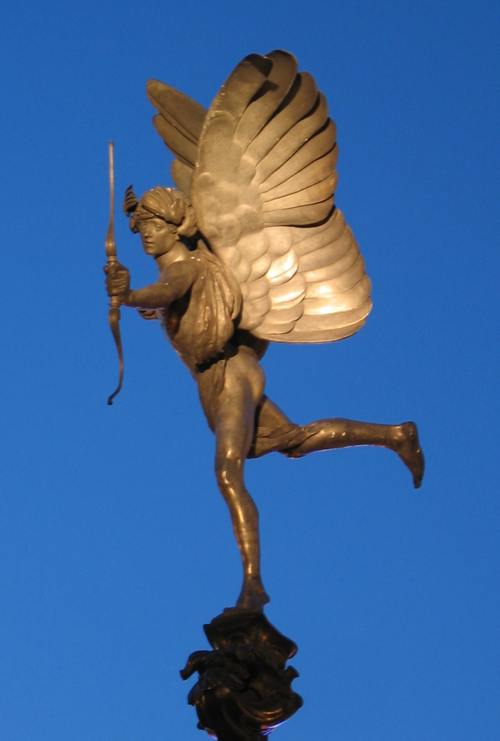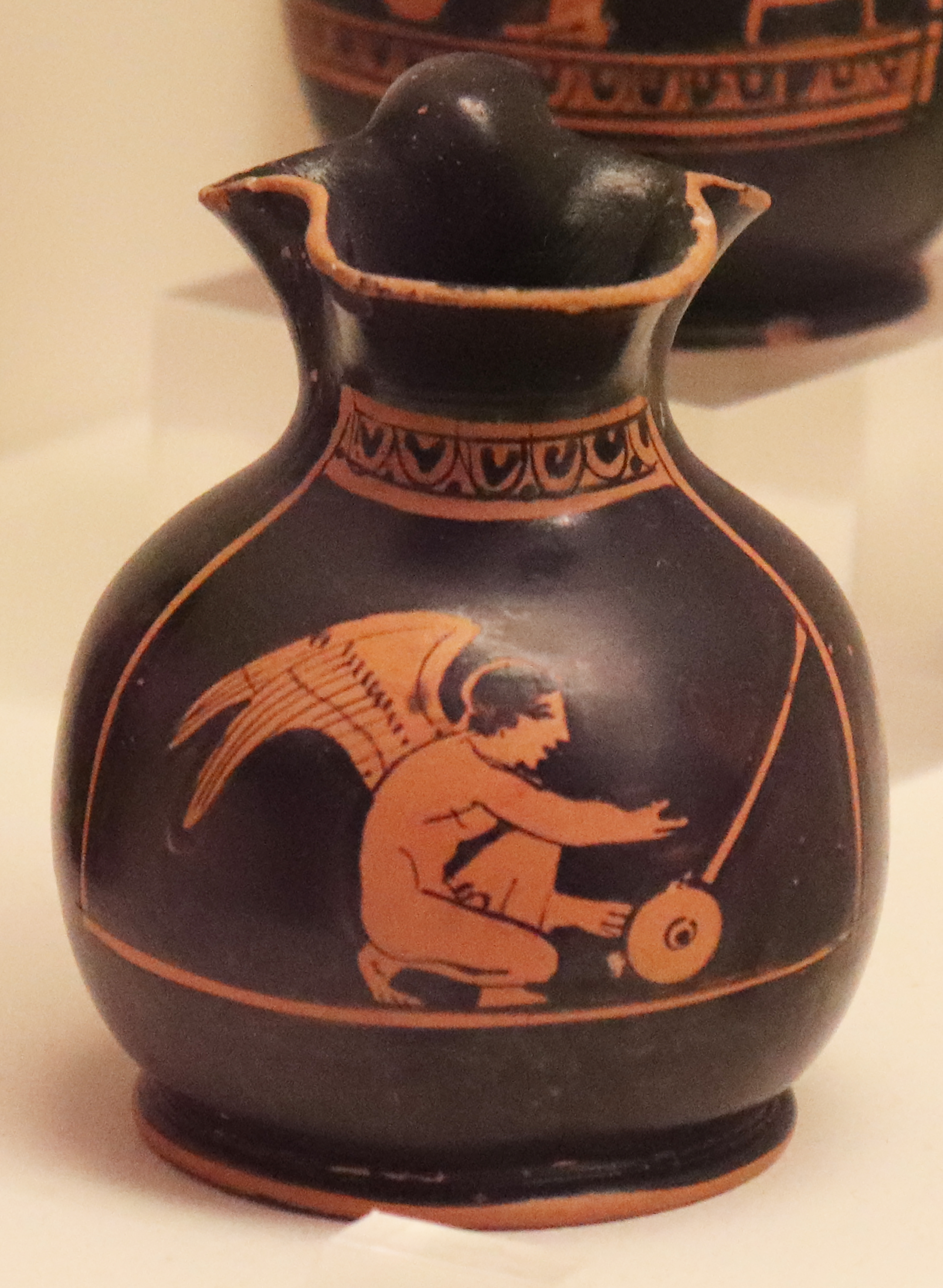|
Erotes
In Ancient Greek religion and mythology, the Erotes (; , ''érōtes'') are a collective of winged gods associated with love and sexual intercourse. They are part of Aphrodite's retinue. ''Erotes'' is the plural of ''Eros'' ("Love, Desire"), who as a singular deity has a more complex mythology. Other named Erotes are Anteros ("Love Returned"), Hedylogos ("Sweet-talk"), Hermaphroditus ("Hermaphrodite" or "Effeminate"), Himeros ("Impetuous Love" or "Pressing Desire"), Hymenaios ("Bridal-Hymn"), and Pothos ("Desire, Longing", especially for one who is absent). The Erotes became a motif of Hellenistic art, and may appear in Roman art in the alternate form of multiple Cupids or Cupids and Psyches. In the later tradition of Western art, Erotes become indistinguishable from figures also known as Cupids, amorini, or amoretti. General role and attributes The Erotes are a group of winged gods in Classical mythology. They are associated with love and sexual desire, and form part of ... [...More Info...] [...Related Items...] OR: [Wikipedia] [Google] [Baidu] |
Himeros
In Greek mythology, Himeros (, lit. 'desire') is one of the seven Erotes, a group of winged love deities, and part of Aphrodite's procession. Often described as "sweet", he is the god and personification of desire and lust. In Hesiod's ''Theogony'', Eros and Himeros were present at Aphrodite's birth and escorted the goddess as she emerged out of the sea foam and joined the assembly of the gods. Earlier in Theogony, Himeros is mentioned as a resident of Mount Olympus, being a neighbor of the Muses and the Charites. Himeros (desire) and Philotes (affection) were bestowed upon the world by Aphrodite initiating sexual encounter; they spoke words of love and winning talk that affected the minds (''nous'') and hearts of mortals and gods alike. Himeros is closely associated with Pothos, the personification of passionate longing. In his dialogue ''Cratylus'', Plato points out the difference between the two concepts explaining that, in the case of Himeros, the object of desire is pres ... [...More Info...] [...Related Items...] OR: [Wikipedia] [Google] [Baidu] |
Cupid
In classical mythology, Cupid ( , meaning "passionate desire") is the god of desire, erotic love, attraction and affection. He is often portrayed as the son of the love goddess Venus and the god of war Mars. He is also known as Amor (Latin: ', "love"). His Greek counterpart is Eros.''Larousse Desk Reference Encyclopedia'', The Book People, Haydock, 1995, p. 215. Although Eros is generally portrayed as a slender winged youth in Classical Greek art, during the Hellenistic period, he was increasingly portrayed as a chubby boy. During this time, his iconography acquired the bow and arrow that represent his source of power: a person, or even a deity, who is shot by Cupid's arrow is filled with uncontrollable desire. In myths, Cupid is a minor character who serves mostly to set the plot in motion. He is a main character only in the tale of Cupid and Psyche, when wounded by his own weapons, he experiences the ordeal of love. Although other extended stories are not told about hi ... [...More Info...] [...Related Items...] OR: [Wikipedia] [Google] [Baidu] |
Aphrodite
Aphrodite (, ) is an Greek mythology, ancient Greek goddess associated with love, lust, beauty, pleasure, passion, procreation, and as her syncretism, syncretised Roman counterpart , desire, Sexual intercourse, sex, fertility, prosperity, and victory. Aphrodite's major symbols include seashells, Myrtle (common), myrtles, roses, doves, sparrows, and swans. The cult of Aphrodite was largely derived from that of the Ancient Canaanite religion, Phoenician goddess Astarte, a cognate of the East Semitic goddess Ishtar, whose cult was based on the Sumerian religion, Sumerian cult of Inanna. Aphrodite's main cult centers were Kythira, Cythera, Cyprus, Corinth, and Athens. Her main festival was the Aphrodisia, which was celebrated annually in midsummer. In Laconia, Aphrodite was worshipped as a warrior goddess. She was also the patron goddess of Prostitution in ancient Greece, prostitutes, an association which led early scholars to propose the concept of sacred prostitution in Greco-Rom ... [...More Info...] [...Related Items...] OR: [Wikipedia] [Google] [Baidu] |
Hedylogos
Hedylogos () is a figure who appears in ancient Greek vase paintings. A surviving example on a red-figure pyxis from the late 5th century BC shows Hedylogos, alongside his brother Pothos, drawing the chariot of Aphrodite. An oenochoe, originating from close to Thebes and dating to around 370 BC, also depicts him alongside Aphrodite. Notes References * Further reading * Shapiro, Harvey Alan, Personifications in Greek art: The Representation of Abstract Concepts, 600-400 B.C.', Kilchberg, Akanthus, 1993. . {{Greek-deity-stub Greek love and lust gods Children of Aphrodite Personifications in Greek mythology Erotes ... [...More Info...] [...Related Items...] OR: [Wikipedia] [Google] [Baidu] |
Eros
Eros (, ; ) is the Greek god of love and sex. The Romans referred to him as Cupid or Amor. In the earliest account, he is a primordial god, while in later accounts he is the child of Aphrodite. He is usually presented as a handsome young man, though in some appearances he is a juvenile boy full of mischief, ever in the company of his mother. In both cases, he is winged and carries his signature bow and arrows, which he uses to make both mortals and immortal gods fall in love, often under the guidance of Aphrodite. His role in myths is mostly complementary, and he often appears in the presence of Aphrodite and the other love gods and often acts as a catalyst for people to fall in love, but has little unique mythology of his own; the most major exception being the myth of Eros and Psyche, the story of how he met and fell in love with his wife. Eros and Cupid, are also known, in art tradition, as a Putto (pl. Putti). The Putto's iconography seemed to have, later, influenced t ... [...More Info...] [...Related Items...] OR: [Wikipedia] [Google] [Baidu] |
Hermaphroditus
In Greek mythology, Hermaphroditus (; , ) was a child of Aphrodite and Hermes. According to Ovid, he was born a remarkably beautiful boy whom the naiad Salmacis attempted to rape and prayed to be united with forever. A god, in answer to her prayer, merged their two forms into one and transformed him into a hermaphrodite. His name is compounded of his parents' names, Hermes and Aphrodite. Because Hermaphroditus was a child of Hermes, and consequently a great-grandchild of Atlas (Hermes's mother Maia was the daughter of Atlas), he is sometimes called Atlantiades (). Symbolism Hermaphroditus, the two-sexed child of Aphrodite and Hermes (Venus and Mercury), had long been a symbol of androgyny or effeminacy, and was portrayed in Greco-Roman art as a female figure with male genitals. Theophrastus's account also suggests a link between Hermaphroditus and the institution of marriage. The reference to the fourth day of the month is telling (see Literature section below): this is the ... [...More Info...] [...Related Items...] OR: [Wikipedia] [Google] [Baidu] |
Theatre
Theatre or theater is a collaborative form of performing art that uses live performers, usually actors to present experiences of a real or imagined event before a live audience in a specific place, often a Stage (theatre), stage. The performers may communicate this experience to the audience through combinations of gesture, speech, song, music, and dance. It is the oldest form of drama, though live theatre has now been joined by modern recorded forms. Elements of art, such as painted scenery and stagecraft such as lighting are used to enhance the physicality, presence and immediacy of the experience. Places, normally buildings, where performances regularly take place are also called "theatres" (or "theaters"), as derived from the Ancient Greek θέατρον (théatron, "a place for viewing"), itself from θεάομαι (theáomai, "to see", "to watch", "to observe"). Modern Western theatre comes, in large measure, from the theatre of ancient Greece, from which it borrows tec ... [...More Info...] [...Related Items...] OR: [Wikipedia] [Google] [Baidu] |
Nude
Nudity is the state of being in which a human is without clothing. While estimates vary, for the first 90,000 years of pre-history, anatomically modern humans were naked, having lost their body hair, living in hospitable climates, and not having developed the crafts needed to make clothing. As humans became behaviorally modern, body adornments such as jewelry, tattoos, body paint and scarification became part of non-verbal communications, indicating a person's social and individual characteristics. Indigenous peoples in warm climates used clothing for decorative, symbolic or ceremonial purposes but were often nude, having neither the need to protect the body from the elements nor any conception of nakedness being shameful. In many societies, both ancient and contemporary, children might be naked until the beginning of puberty. Women may not cover their breasts due to the association with nursing babies more than with sexuality. In the ancient civilizations of the Medi ... [...More Info...] [...Related Items...] OR: [Wikipedia] [Google] [Baidu] |
Frieze
In classical architecture, the frieze is the wide central section of an entablature and may be plain in the Ionic order, Ionic or Corinthian order, Corinthian orders, or decorated with bas-reliefs. Patera (architecture), Paterae are also usually used to decorate friezes. Even when neither column (architecture), columns nor pilasters are expressed, on an astylar wall it lies upon the architrave ("main beam") and is capped by the molding (decorative), moldings of the cornice (architecture), cornice. A frieze can be found on many Greek and Roman buildings, the Parthenon Frieze being the most famous, and perhaps the most elaborate. In interiors, the frieze of a room is the section of wall above the picture rail and under the crown moldings or cornice. By extension, a frieze is a long stretch of painting, painted, sculpture, sculpted or even calligraphy, calligraphic decoration in such a position, normally above eye-level. Frieze decorations may depict scenes in a sequence of ... [...More Info...] [...Related Items...] OR: [Wikipedia] [Google] [Baidu] |
Goat
The goat or domestic goat (''Capra hircus'') is a species of Caprinae, goat-antelope that is mostly kept as livestock. It was domesticated from the wild goat (''C. aegagrus'') of Southwest Asia and Eastern Europe. The goat is a member of the family Bovidae, meaning it is closely related to the sheep. It was one of the first animals to be domesticated, in Iran around 10,000 years ago. Goats have been used for milk, Goat meat, meat, Animal fur, wool, and Animal skin, skins across much of the world. Milk from goats is often turned into goat cheese, cheese. In 2022, there were more than 1.1 billion goats living in the world, of which 150 million were in India. Goats feature in mythology, folklore, and religion in many parts of the world, including in the classical myth of Amalthea (mythology), Amalthea, in Tanngrisnir and Tanngnjóstr, the goats that pulled the chariot of the Norse god Thor, in the Scandinavian Yule goat, and in Hinduism's goat-headed Daksha. In Christianity and ... [...More Info...] [...Related Items...] OR: [Wikipedia] [Google] [Baidu] |
Hunting
Hunting is the Human activity, human practice of seeking, pursuing, capturing, and killing wildlife or feral animals. The most common reasons for humans to hunt are to obtain the animal's body for meat and useful animal products (fur/hide (skin), hide, bone/tusks, horn (anatomy), horn/antler, etc.), for recreation/taxidermy (see trophy hunting), although it may also be done for resourceful reasons such as removing predators dangerous to humans or domestic animals (e.g. wolf hunting), to pest control, eliminate pest (organism), pests and nuisance animals that damage crops/livestock/poultry or zoonosis, spread diseases (see varmint hunting, varminting), for trade/tourism (see safari), or for conservation biology, ecological conservation against overpopulation and invasive species (commonly called a culling#Wildlife, cull). Recreationally hunted species are generally referred to as the ''game (food), game'', and are usually mammals and birds. A person participating in a hunt is a ... [...More Info...] [...Related Items...] OR: [Wikipedia] [Google] [Baidu] |










